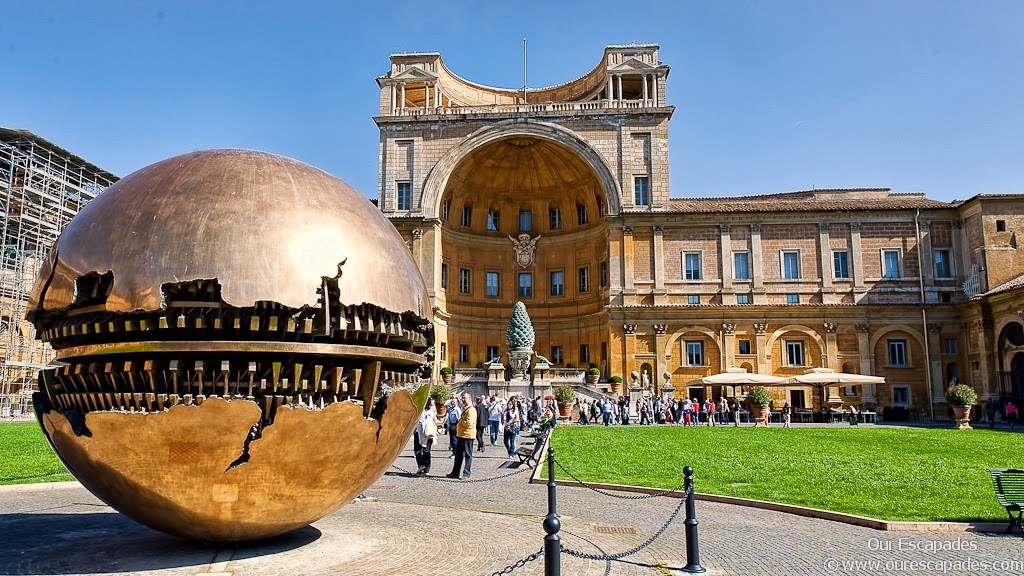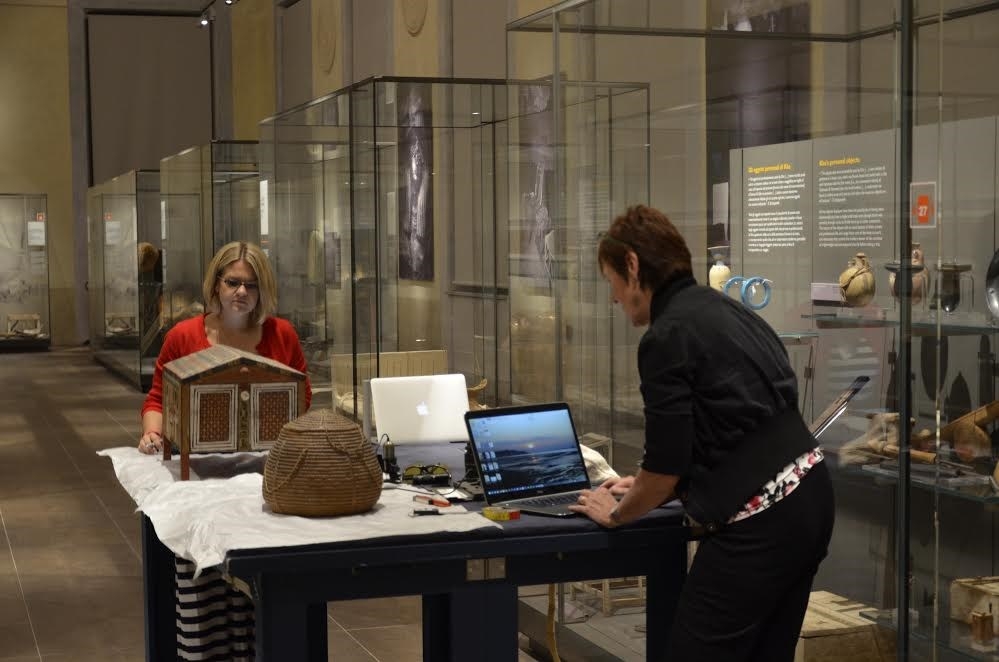Past Events
Interested in Cotsen events? Sign up for our mailing list.Speaker: David Scott, Professor, UCLA Department of Art History and UCLA/Getty Conservation Program

The San Diego Museum of Man has a collection of Saite and Ptolemaic coffins and mummies which were the subject of a technical study from 2007-2009. Pigments, binding media, grounds, wood and degradation products were characterized by x-ray diffraction analyses, x-ray fluorescence spectroscopy, polarized light microscopy, wood anatomy, gas chromatography mass spectrome try and Elisa, a synopsis of the results of the study will be presented with examples of specific coffins illustrated.
Contact Matthew Swanson
Email mswanson@ioa.ucla.edu
Phone
Speaker: Deidre Whitmore, Cotsen Institute of Archaeology
The Digital Archaeology Lab (DAL) aims to support the technological needs of the Cotsen faculty, students and staff by providing facilities, advice, and training. This talk will provide an overview of the facilities including the equipment that is available and how to access it (both in-person and remotely), and the consulting services offered by the lab manager. The topics and dates for the first workshops and training sessions will be announced and the audience will have a chance to request additional topics. For more information about the DAL visit www.ioa.ucla.edu/labs/dal.
Contact Matthew Swanson
Email mswanson@ioa.ucla.edu
Phone
Speakers: Dr. James Snead, California State University, Northridge; Austin Ringelstein, National Park Service
Archaeologists working within they landscape paradigm have increasingly begun directing attention toward the subject of movement. Recent work has underlined the centrality of "motion" to the human experience, creating a body of theoretical and empirical literature that has wide application. This presentation will discuss new fieldwork on Yap, in the Eastern Caroline islands of Micronesia. Famous among anthropologists for "stone money" (or rai), the remarkable built environment of Yap also includes hundreds of kilometers of stone paths. Documentation of these features, including physical mapping as well as the collection of ethnographic information, is being conducted in collaboration with the Historic Preservation Department of Yap State. More than mere routes of convenience, the paths have been called "roads of social responsibility" and are fundamental organizational elements of Yapese society. Their study, supported by the Cotsen Institute, provides a distinctive case study for landscape archaeology.
Contact Matthew Swanson
Email mswanson@ioa.ucla.edu
Phone
Speaker: Dr. Richard Lesure, Cotsen Institute of Archaeology
Lesure will report on the work of a team of archaeologists from the UCLA Anthropology Department and Cotsen Institute of Archaeology who are trying to understand the demographic impact of the transition to agriculture at a continental scale. The area of interest is Greater Middle America, roughly from southern Utah (USA) to the Panama Canal. We build on recent studies of the Agricultural Demographic Transition (or ADT) and on efforts to trace expansions by early farmers on scales approaching the continental. Our argument in this paper is that the ADT in Middle America was long and bumpy, involving at least two eras of very rapid population growth. In much of Middle America, those periods of highgrowth can be identified as the demographic effects of, in succession, an Early-Maize Formative and a Maize-Staple Formative. The Early-Maize Formative tended to lead to localized population concentrations (including villages of more than 10 ha) within a larger landscape still sparsely populated. Well attested radial expansions of farmers from agricultural heartlands are instead a recurring feature of the Maize-Staple Formative; their spatial extents prove to be significantly smaller than continental. We suggest that, in Middle America, analysis at a macroregional scale of 10-40,000 km² is crucial in the effort to understand continental-scale patterns in the transition to agriculture.
Contact Matthew Swanson
Email mswanson@ioa.ucla.edu
Phone
Speaker: Dr. David Scott, Cotsen Institute of Archaeology
Due to unforeseen circumstances, this Pizza Talk has been cancelled. We will work to reschedule it in the new year.
Contact Matthew Swanson
Email mswanson@ioa.ucla.edu
Phone
Speaker: Dr. Barbara Horejs, Director of the Institute for Oriental and European Archaeology, Austrian Academy of Sciences
The excavations of Çukuriçi Höyük at the Aegean coast of Turkey revealed intensive metallurgical activities dating to the Early Bronze Age I period in early 3rd millennium BC. Beyond a high number of metal artefacts, the complete chaîne opératoire of metal production can also be reconstructed based on raw materials, slags, crucibles, a variety of tools and half-finished products. These finds and metallurgical remains have been analysed by using various analytical methods to describe the "geochemical fingerprint" of the metals used, mainly arsenical copper. The data will be discussed in relation to the known copper ore deposits in Turkey and the Aegean in order to identify the provenance of the metals. The second focus of this paper is set on the intensity of metal production at Çukuriçi Höyük and its further socio-cultural interpretation. The evidence of around 50 metal workshops embedded within several settlement districts give clear hints for the impact of this specialized production to the local community. Further archaeological indicators like faunal remains and textile technology will be discussed in relation to the potential division of labour, specialization and off-site activities, supported by aspects of spatial analyses of Çukuriçi Höyük settlements IV and III (2900–2750 calBC).

Fig.: Visualization of the EBA 1 settlement at Çukuriçi Höyük based on excavation results and geophysical surveys (©ERC Prehistoric Anatolia/7 reasons).
Contact Matthew Swanson
Email mswanson@ioa.ucla.edu
Phone
Speaker: Dr. Mary Louise Hart, Getty Museum
The last several years have seen extensive research and conservation of the Getty Villa’s collection of Romano-Egyptian panel paintings, which contain a good collection of mummy portraits dating from around AD 50 to about AD 220, the in situ portrait of a red-shroud mummy, and a “group” of Isis and Serapis flanking a square portrait of a mortal man (above). Recently this group – cataloged as a triptych by the museum upon its acquisition in 1974 – underwent an analytical update [published in “A Portrait of a Bearded Man Flanked by Isis and Serapis” published in Icon, Cult and Context (Cotsen, 2016), 79-89]. Past analytical work focused on understanding the materials and authenticity of the panels but had not presented new information about their ancient context or function. More recent organic analysis has revealed a number of different components assuring the ancient integrity and commonality of the panels but has also uncovered evidence of modern restoration in need of clarification. The complex story of origin, restoration, conservation and display inspired the organization of an international exhibition of Romano-Egyptian mummy portraits, shrouds, and associated artifacts (including mummies) for the Getty Villa in the fall of 2019.

Contact Matthew Swanson
Email mswanson@ioa.ucla.edu
Phone
Speaker: Alessia Amenta, Vatican Museums
The Vatican Coffin Project gathers an international team of scholars who are divided into three groups with three different areas of expertise: Egyptology, Diagnostic and Conservation. The project has three objectives: the study of the construction and painting techniques of coffins, the identification of workshop patterns and the understanding of the 'packaging' of a coffin. Our work is also aimed at elaborating a protocol for the conservation of the artifacts. The last frontier is the study of paleography of the painted scenes and of the texts. Since new technologies applied to the study of ancient Egyptian coffins undergo constant improvement, this talk will provide an overview of the latest developments.

Contact Matthew Swanson
Email mswanson@ioa.ucla.edu
Phone
Speaker: Willeke Wendrich, Director of the Cotsen Institute of Archaeology
UCLA has started a close collaboration with the Museo Egizio in Turin, which holds the most important collection of material culture from ancient Egypt after the museum in Cairo. This pizza talk will highlight the research that has been started in the summer of 2016.

Contact Matthew Swanson
Email mswanson@ioa.ucla.edu
Phone
Speaker: Dr. Caroline Cartwright, Department of Scientific Research, The British Museum
Dr Caroline Cartwright is the Senior Scientist and Wood Anatomist in the Department of Scientific Research at the British Museum. Her primary areas of scientific expertise cover the identification and interpretation of organics such as wood, charcoal, fibres, macro plant remains, shell, ivory and bone from all areas and time periods in the British Museum’s collections, including for CITES (Convention on International Trade in Endangered Species). She has led many teams of archaeobotanists, archaeozoologists and human osteologists on archaeological projects in various parts of the world including the Middle East, Africa, the Caribbean and Europe. Reconstructing past environments, charting vegetation and climate changes, and investigating bioarchaeological evidence from sites and data, all form an important part of her research. Prior to joining the British Museum, Caroline was a Lecturer and Research Fellow at the Institute of Archaeology, University College London.
Contact Matthew Swanson
Email mswanson@ioa.ucla.edu
Phone
- ‹ previous
- 18 of 21
- next ›


